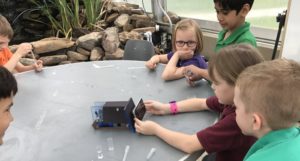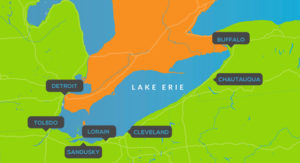HRWC pilots low-cost spectrophotometer to analyze water pollution

Around this time of year, neon green algal blooms begin to form in Lake Erie, undermining recreation, water quality, and community well-being. The Huron River is undoubtedly a part of the problem as it carries polluted runoff containing phosphorus and nitrogen, known as nutrients, to Lake Erie. That also means the Huron can be part of the solution to mitigating these nasty blooms and improving water quality. With new technologies, HRWC is testing inventive new means to improve water quality monitoring and reduce nutrient runoff.
Citizen scientists are key
In collaboration with partners from across the Lake Erie basin, HRWC is testing a new low-cost spectrophotometer device to bolster water quality data collection by citizen scientists. The high cost of laboratory-grade nutrient testing and analysis typically inhibits community-based citizen science groups like HRWC from collecting nutrient data. Developed by researchers at the University of Akron, these new spectrophotometer devices would enable HRWC and partners to increase the scale and speed of nutrient testing, and arm partner organizations with the essential data to drive policies and investments that tackle polluted runoff and reduce nutrients going into Lake Erie.

This spring, HRWC was selected by the Cleveland Water Alliance as the Southeast Michigan Local Champion for this larger regional collaboration, called the Smart Citizen Science Initiative. Each Local Champion is sponsored by an area community foundation, with HRWC’s efforts supported by the Community Foundation for Southeast Michigan. This year and next, HRWC will pilot the spectrophotometer devices among its own monitoring programs, including the Chemistry and Flow Monitoring Program and the River Roundup macroinvertebrate collection, and look for opportunities to distribute the devices to other Southeast Michigan water organizations working with citizen scientists. Starting this past June, HRWC staff collected bimonthly samples from 20 sites in Wayne and Washtenaw counties and brought the samples back to their newly established home “labs” for analysis using the device. Staff will continue to sample and send duplicate samples to a professional lab for side-by-side evaluation. Such comparison will help the team determine the devices’ overall precision and accuracy.
Accessible tools in the field
The 3D-printed spectrophotometer shines light beams through water samples and a diffractor to produce visible light spectra that are brighter or darker depending on the sample’s nutrient concentrations. A smartphone camera and app analyze the light spectra to produce an absorbance value, a measurement of the light wavelengths passing through a sample. HRWC then converts the absorbance values into nutrient concentrations for use in water quality analyses.
While testing the devices this past summer, HRWC identified potential challenges with more widespread use. In the offseason, HRWC will work with project partners to remedy these issues in time for the 2021 monitoring season. HRWC looks forward to continued partnership on this innovative project to improve water quality data accessibility and advance new technology.
This blog post was originally published September 1st in the Huron River Report, Fall 2020.



